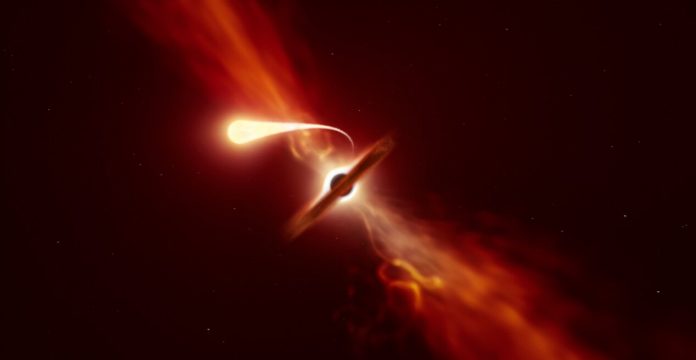An unusual blast of light has been spotted bursting out of a star as it was eaten – yes, eaten – by a black hole.
Astronomers all over the world witnessed what they described as a ‘tidal disruption event’ through telescopes, as the bright light popped up 215 million light-years away.
Although that sounds pretty damn far, it’s actually the closest tidal disruption event ever recorded.
The star was sucked in by the black hole’s gravitational pull, and in the meantime, it went through a process called spaghettification. Sadly, this has nothing to do with Italian food.
As it was pulled in, the star was essentially shredded into thin strips – like spaghetti – with some falling into the black hole. However, this caused a spike energy, which is then unleashed into the universe and can often be spotted by astronomers here on Earth.
Lead author of the study and lecturer and Royal Astronomical Society research fellow at the University of Birmingham, Dr Matt Nicholl, said, as per the Independent:
The idea of a black hole ‘sucking in’ a nearby star sounds like science fiction. But this is exactly what happens in a tidal disruption event.
We were able to investigate in detail what happens when a star is eaten by such a monster.
Tidal disruption events aren’t always visible because of a build up of debris and dust, but this time telescopes all over the world were able to witness the event over a six-month period, as it grew brighter by the day.
Samantha Oates, from the University of Birmingham, added:
When a black hole devours a star, it can launch a powerful blast of material outwards that obstructs our view.
This happens because the energy released as the black hole eats up stellar material propels the star’s debris outwards.
Because of their poor visibility, research on such events has been difficult in the past, but fortunately, scientists were able to study this event in-depth, because it had been detected from Earth just moments after it was shredded into pieces.
Thomas Wevers, an ESO Fellow in Santiago, Chile, said:
Several sky surveys discovered emission from the new tidal disruption event very quickly after the star was ripped apart.
We immediately pointed a suite of ground-based and space telescopes in that direction to see how the light was produced.
Now, scientists have a better understanding than ever before of how the flare and debris would usually block the visibility.
































